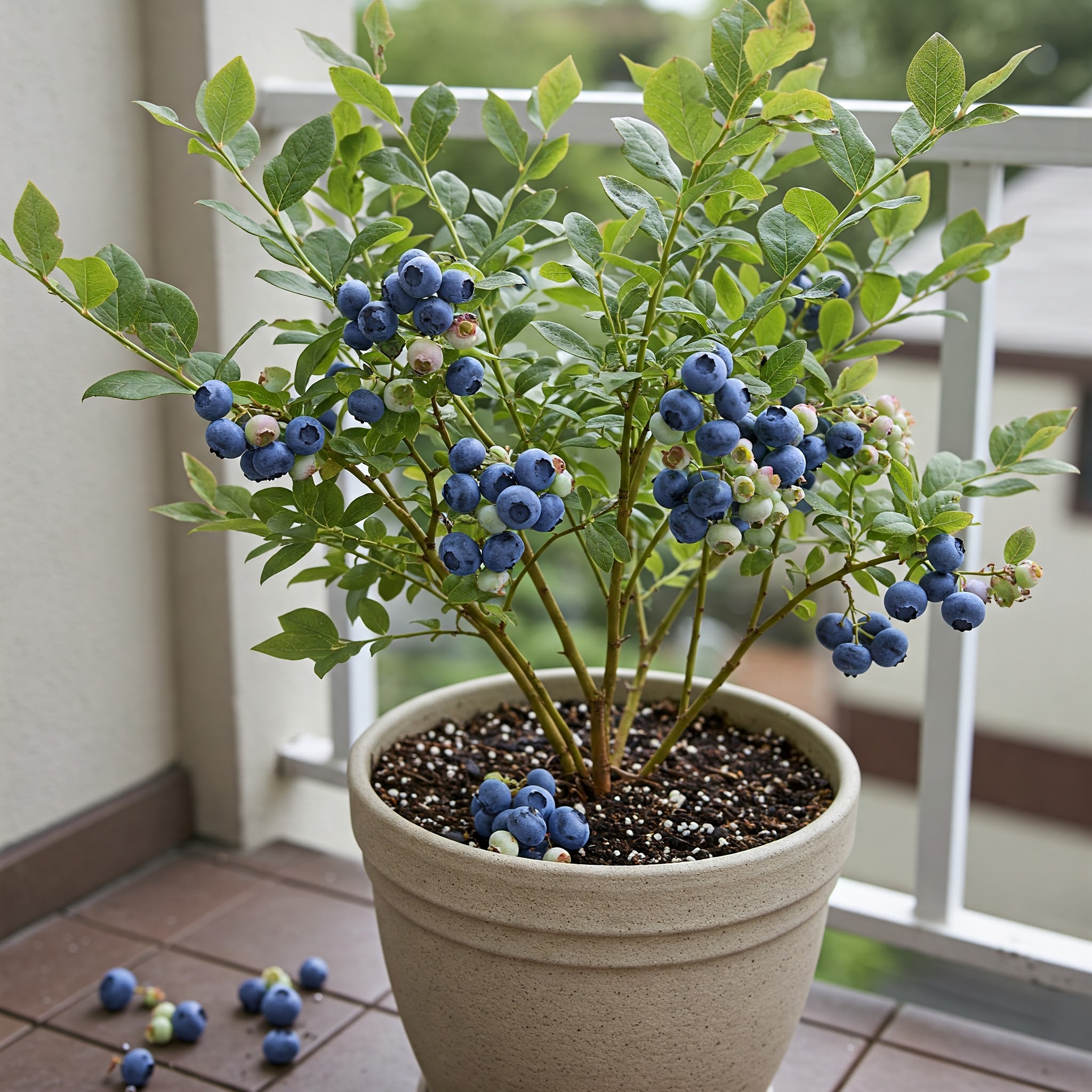Blueberries are not only delicious and versatile, but they also pack an incredible nutritional punch. With high levels of antioxidants, vitamin C, fiber, and essential minerals, blueberries are a staple in many healthy diets. From smoothies and salads to desserts and snacks, these berries can easily be incorporated into any meal. The good news is that you don’t have to buy them from the store every time you need them. By following a few simple steps, you can grow blueberries at home and have a continuous supply of fresh, homegrown berries year-round. Here’s a complete guide on how to cultivate blueberries in your own garden or containers.
The Benefits of Growing Blueberries at Home
Before diving into the growing process, let’s take a closer look at why blueberries are worth the effort to grow at home.
1. Nutritional Powerhouse
Blueberries are known for their rich nutritional profile, packed with vitamins, antioxidants, and fiber. They’re high in vitamin C, which is crucial for immune health, and are also a great source of potassium, calcium, and iron. These nutrients help support various bodily functions, including cardiovascular health, bone strength, and nerve function.
In addition to being nutrient-dense, blueberries are also rich in antioxidants, particularly anthocyanins, which give the berries their deep blue color. These antioxidants can help fight oxidative stress, inflammation, and aging, contributing to improved heart health and potentially reducing the risk of chronic diseases like cancer.
2. Easy to Grow
Blueberries are relatively easy to grow, especially if you live in a region with the right climate. With a bit of attention to their specific needs, such as acidic soil, proper watering, and sunlight, you can grow a thriving blueberry bush that produces abundant fruit for years to come.
3. Cost-Effective
Buying fresh blueberries from the store can be expensive, especially when they are out of season. Growing your own blueberries eliminates this cost and ensures that you have a steady supply of fresh fruit whenever you want. Plus, once established, blueberry bushes are perennial, meaning they will produce fruit year after year with minimal effort.
Step-by-Step Guide to Growing Blueberries
Growing blueberries at home requires patience, but with the right approach, you can enjoy a consistent supply of delicious berries. Here’s how to get started:
1. Choose the Right Container or Planting Site
Blueberries are versatile and can be grown in a variety of environments. You can plant them in your garden if you have the space, or you can grow them in containers if you’re limited on space or live in an area with cooler climates.
If you’re planting in the ground, make sure the site has well-draining, acidic soil with a pH level between 4.5 and 5.5. Blueberries thrive in full sunlight, so choose a spot that receives at least 6-8 hours of sunlight per day. If you’re growing them in containers, choose a large pot with good drainage. Containers should be at least 12-16 inches in diameter to accommodate the root system of the plant.
2. Select the Right Variety of Blueberries
There are several varieties of blueberries to choose from, each with different characteristics. The two most common types are highbush blueberries and lowbush blueberries.
Highbush Blueberries: These are the most popular type for home gardeners and can grow up to 6 feet tall. They require a larger space but produce larger fruit and higher yields.
Lowbush Blueberries: These are smaller, ground-hugging plants that are often used for ornamental purposes or in smaller spaces. While the fruit is smaller, it is equally delicious.
Choose a variety that is suited to your climate. Some varieties are better for warmer climates, while others are more suitable for cooler, northern regions.
3. Prepare the Soil
Blueberries require acidic soil to thrive. Most garden soils are too alkaline for blueberries, so you’ll need to amend the soil to create the right environment for them. You can purchase an acidic soil mix or use materials like peat moss, pine bark, or compost to lower the pH. Aim for a soil pH between 4.5 and 5.5.
If you’re growing blueberries in containers, you can buy a pre-made acidic potting mix or create your own by mixing equal parts of peat moss, pine bark, and perlite.
4. Planting Blueberries
Once you’ve prepared the soil or selected your container, it’s time to plant the blueberries. If you’re starting with a young plant, dig a hole that is just large enough to fit the root ball of the plant. The hole should be about 2-3 times the size of the root ball. Place the plant in the hole and fill it with soil, making sure the top of the root ball is level with the surrounding soil.
For container-grown blueberries, simply fill the pot with the prepared acidic soil mix, leaving about an inch of space at the top for watering.
5. Watering and Humidity
Blueberries need consistent moisture to thrive, but they do not like sitting in waterlogged soil. Water the plants regularly, especially during dry spells, but allow the soil to dry out slightly between waterings. Overwatering can lead to root rot, so ensure the soil drains well.
Blueberries also prefer high humidity. If you live in a dry climate or are growing them indoors, you may want to mist the plants occasionally or place a humidity tray beneath the pot.
6. Fertilizing Blueberries
Blueberries have specific nutritional needs, so it’s important to fertilize them correctly. Use a fertilizer formulated specifically for acid-loving plants, and avoid using fertilizers with high nitrogen content, as these can harm the plant. Fertilize in the early spring before new growth begins and again in the late summer to encourage strong fruit production.
7. Pruning and Maintenance
Blueberry bushes need regular pruning to promote healthy growth and fruit production. The best time to prune is in late winter or early spring when the plant is still dormant. Remove any dead or damaged wood, and trim back any weak or crossing branches. Pruning helps the plant focus its energy on producing strong, healthy branches that will bear more fruit.
8. Harvesting Blueberries
Blueberries typically start producing fruit in the second or third year after planting. When the berries are fully ripe, they will be a deep blue color. To harvest, simply pluck the berries off the bush. You can store freshly harvested blueberries in the refrigerator for up to a week, or freeze them for long-term storage.
Tips for a Bountiful Blueberry Harvest
Mulching: Mulch your blueberry plants with pine needles or wood chips to help retain moisture, suppress weeds, and maintain an acidic environment.
Cross-Pollination: Blueberries benefit from cross-pollination, so planting two or more different varieties can lead to better fruit yields.
Pest Control: Keep an eye out for pests like aphids and caterpillars, which can damage the plants. Use organic pest control methods or insecticidal soap to keep them at bay.
Conclusion
Growing blueberries at home is a rewarding experience that provides fresh, nutritious fruit year after year. By following the steps outlined above—choosing the right container, soil, variety, and maintaining proper care—you can cultivate a thriving blueberry plant that will yield delicious, antioxidant-rich fruit. Not only will you enjoy the benefits of fresh, homegrown blueberries, but you’ll also have the satisfaction of knowing exactly where your food comes from. Whether you’re growing them in your garden or in a container on your balcony, blueberries are a low-maintenance, high-reward fruit that anyone can grow with a little patience and care. Happy gardening!
More Articles You Might Like
-
Texas Toast Sloppy Joes: The Crunchy, Cheesy Upgrade You Didn’t Know You Needed
There’s something timeless about sloppy joes. For generations, this saucy, savory, and slightly sweet ground beef sandwich has been a go-to comfort food in American kitchens. It’s quick, filling, and family-friendly—perfect for busy weeknights. But what if we told you there’s a way to take this classic dish up a notch? Enter the Texas Toast…
-
Classic Pig Pickin’ Cake
When it comes to Southern desserts, few sweets shine as brightly as the Classic Pig Pickin’ Cake. This nostalgic cake, sometimes called a “Mandarin Orange Cake,” has roots deep in Southern tradition. It gets its playful name from its frequent appearance at pig pickin’s—Southern-style barbecue gatherings where communities come together to enjoy slow-cooked pork, sides,…
-
Lemon Garlic Butter Chicken with Creamy Parmesan Pasta
There’s something irresistible about the combination of tender, golden-browned chicken paired with a creamy pasta coated in Parmesan cheese. Add the brightness of lemon, the depth of garlic, and the richness of butter, and you have a recipe that feels indulgent yet approachable enough for a weeknight dinner. Lemon Garlic Butter Chicken with Creamy Parmesan…



